2 Employment and unemployment in 2013
2.1 Employment weakened in 2013
Number of employed persons decreased from the previous year
According to Statistics Finland's Labour Force Survey, the employment rate for the population aged 15 to 64 was 68.5 per cent in 2013. The employment rate was 0.5 percentage points lower than in 2012. Men’s employment rate was 69.2 per cent and women’s 67.8 per cent. Men's employment rate went down by 0.6 percentage points and women's by 0.3 percentage points from 2012. (Figure 1.)
Population changes have an effect on the employment rate as well. The population aged 15 to 64 has decreased in the past few years as large age groups born after the wars have moved to the age group of those aged 65 to 74.
Figure 1. Employment rates by sex in 1991–2013 persons aged 15 to 64, %
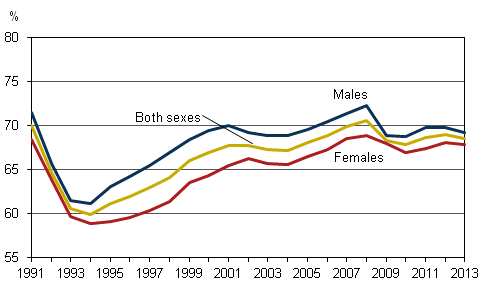
In 2013, the number of employed persons was 2,457,000, which was 27,000 lower than in 2012 (Figure 2). The number of employed persons decreased in all quarters of 2013 compared to the corresponding quarters of 2012.
Figure 2. Number of employed persons by sex in 1991–2013 persons aged 15 to 74
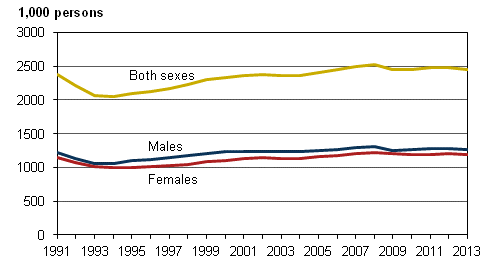
There were 2,127,000 employees in 2013, which was 20,000 fewer than in the previous year. The number of self-employed persons also decreased slightly from 2012. In 2013, the total number of self-employed persons and unpaid family workers was 330,000. Of this, the share of unpaid family workers was 11,000. The share of self-employed persons and unpaid family workers among the employed was 13 per cent in 2013.
Women's employment weakened as well
Unlike in the two previous years, women's employment rate also weakened from 2012 to 2013. The number of employed women decreased by 11,000 persons and that of employed men by 16,000 persons compared to 2012. Figure 3 shows a time series on changes in the number of employed persons by sex. Among different age groups, employment weakened most in the 35 to 44 age group from the year before (Figure 4).Figure 3. Change from the previous year in the number of employed persons by sex in 1993-2013, persons aged 15 to 74
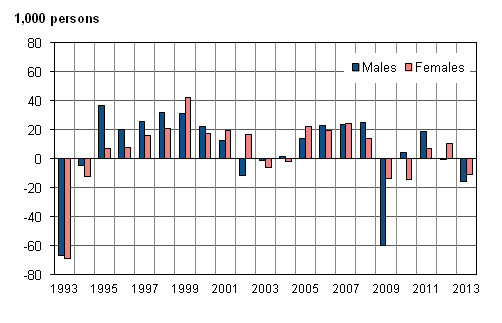
Figure 4. Employment rates by age group in 1991–2013, %
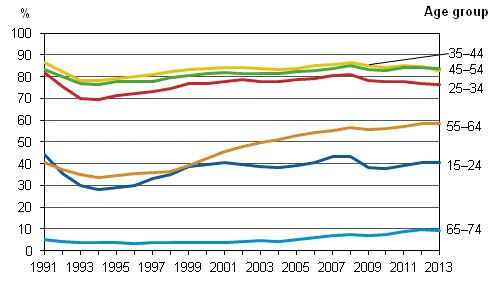
Number of employed persons decreased most in human health and social work activities and in manufacturing
Figure 5 shows the change from the previous year in the number of employed persons by industry in 2012 and 2013. The number of employed persons did not grow much in any industry from 2012 to 2013. In human health and social work activities (Q), which grew heavily in previous years, the number of employed decreased by 9,000 persons from 2012 to 2013. In manufacturing (C-E), the number of employed persons diminished further by 5,000 persons.
Figure 5. Change from the previous year in the number of employed persons by industry in 2012-2013, persons aged 15 to 74
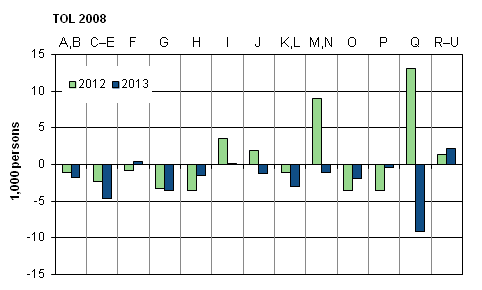
Industries (Standard Industrial Classification TOL 2008)
| A, B | 01–09 | Agriculture, forestry and fishing; mining and quarrying |
| C-E | 10–39 | Manufacturing; electricity, gas, steam and air conditioning and water supply; sewerage and waste management |
| F | 41–43 | Construction |
| G | 45–47 | Wholesale and retail trade; repair of motor vehicles and motorcycles |
| H | 49–53 | Transportation and storage |
| I | 55–56 | Accommodation and food service activities |
| J | 58–63 | Information and communication |
| K, L | 64–68 | Financial, insurance and real estate activities |
| M, N | 69–82 | Professional, scientific and technical activities; administrative and support service activities |
| O | 84 | Public administration and defence; compulsory social security |
| P | 85 | Education |
| Q | 86–88 | Human health and social work activities |
| R–U | 90–99 | Arts, entertainment and recreation; other service activities |
The fall in employment mainly concerned the private sector, which employed 28,000 persons fewer than in 2012. In the public sector, the number of employed persons remained almost unchanged.
Number of hours worked decreased
In 2013, a total of 4.0 billion hours were worked in the whole national economy. The number of hours worked by employed persons decreased by two per cent compared to 2012. The number of hours worked per employed person also decreased slightly. In 2013, the average annual number of hours worked by an employed person was 1,613, whereas in 2012 the respective figure was 1,627.
In 2013, the number of underemployed persons was 119,000, which was 9,000 more than in 2012. Underemployed persons refer to persons working involuntarily part-time or a shortened working week or that have not have work due to a low number of orders or customers or due to being laid off.
2.2 Number of unemployment increased in 2013
Unemployment increased in 2013. In 2013, the average number of unemployed in Finland was 219,000, which was 12,000 more than in 2012. The number of unemployed men was 122,000 and that of women 97,000. The numbers of unemployed men and women both grew by roughly as much. The number of unemployed persons grew in the first, second and fourth quarters compared to the corresponding quarters in 2012.
The unemployment rate was, on average, 8.2 per cent in 2013, having been 7.7 per cent in 2012. Men’s unemployment rate was 8.8 per cent and women’s 7.5 per cent.
In 2013, besides unemployed persons, there were 124,000 persons in the inactive population in so-called disguised unemployment, who would and could have accepted work, but had not looked for it actively. The number of persons in disguised unemployment grew by 11,000 from 2012. The numbers of persons in disguised unemployment were the highest in the 15 to 24 age group (38,000) and in the 55 to 64 age group (32,000). The combined total number of unemployed persons and persons in disguised unemployment was 343,000 in 2013 (Figure 6). (More about persons in disguised unemployment in Section 4.2).
Figure 6. Unemployed persons and persons in disguised unemployment in 1999–2013, persons aged 15 to 74
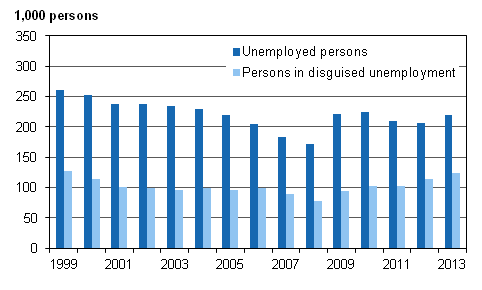
The unemployment rate, that is, the proportion of unemployed in the labour force, among young people aged 15 to 24 was 19.9 per cent in 2013. The proportion was 0.9 percentage points higher than in the previous year. In other age groups, unemployment rates grew less (Figure 7). In the 15 to 24 age group, 66,000 were unemployed, which was nearly one-third of all unemployed persons.
The share of unemployed people aged 15 to 24 among the population in the same age group was around ten per cent in 2013 (Figure 8). The share stayed almost on level with 2012 in 2013.
Figure 7. Unemployment rates by age group in 1991–2013, %
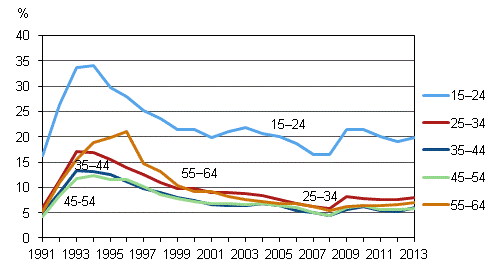
Figure 8. Shares of employed and unemployed persons, and inactive population of age group in 2013 %
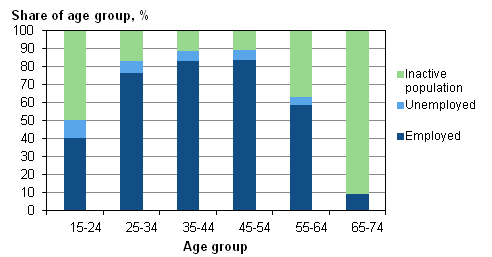
There were an average of 16,000 laid off persons in 2013, which was 4,000 more than in the previous year (Table 1). Of the persons laid off in 2013, 44 per cent were laid off for a fixed period and 56 per cent for the time being. In the Labour Force Survey, 36 per cent of the laid-off persons were defined as employed, 19 per cent as unemployed and 45 per cent as being in the inactive population. More information about the definition of the labour market status of a laid-off person can be found at: http://tilastokeskus.fi/til/tyti/tyti_2013–8–20_men_006_en.html .
Table 1. Laid-off persons aged 15–74 by quarter in 2009–2013
| Year | |||||
| Quarter | 2009 | 2010 | 2011 | 2012 | 2013 |
| I | 38,000 | 35,000 | 18,000 | 17,000 | 21,000 |
| II | 42,000 | 19,000 | 11,000 | 10,000 | 13,000 |
| III | 31,000 | 15,000 | 9,000 | 9,000 | 14,000 |
| IV | 36,000 | 14,000 | 11,000 | 11,000 | 15,000 |
| Annual average | 37,000 | 21,000 | 12,000 | 12,000 | 16,000 |
2.3 Share of the active population decreased
The number of working-age people (aged 15 to 74) grew further by 12,000 persons in Finland from 2012 to 2013. In 2013, the Finnish population included 4,087,000 persons aged 15 to 74. Simultaneously, the number of persons aged 15 to 64 decreased however, as the growth was nearly fully directed at the age group of those aged 65 to 74, which grew by 28,000 persons from the year before. The age group of those aged 55 to 64 diminished by 12,000 persons but still remained the largest age group among people of working age (Figure 9).
The share of the active population, i.e. employed and unemployed persons aged 15 to 74, decreased from 66.0 per cent in 2012 to 65.5 per cent in 2013. The size of the active population shrunk by 14,000 persons.
The size of the inactive population was 1,411,000 persons in 2013. Its size grew by 26,000 persons from the previous year. The growth was mainly caused by an increase of 27,000 persons among the inactive population in the age group of those aged 65 to 74. (More about the inactive population in Section 4).
Figure 9. Population of working age and active population by age group in 2013
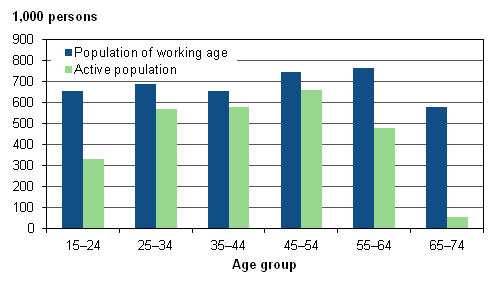
2.4 Number of employees’ contracts of under one year’s duration decreased in 2013
Temporary employment is more widespread among women than men
In 2013, the average number of employees in Finland was 2,127,000, which was 20,000 lower than in 2012. In all, 330,000 employees had temporary employment contracts, of whom 201,000 were women and 129,000 men (Figure 10).
Figure 10. Number of temporary employees aged 15 to 74 by sex in 2001–2013
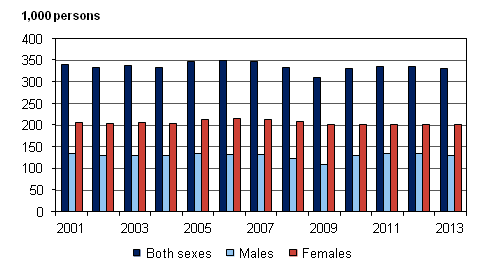
Eighty-four per cent of all employment contracts of employees were permanent and 16 per cent temporary in 2013. The shares remained almost unchanged from the year before. The share of temporary employees was 18 per cent among female employees and 12 per cent among male employees. In recent years the number of temporary female employees has remained almost unchanged. For men, the share of temporary employees was in 2013 still higher than in 2008 and 2009. (Figure 11.)
Figure 11. Share of temporary employees of all employees aged 15 to 74 by sex in 1999-2013, %
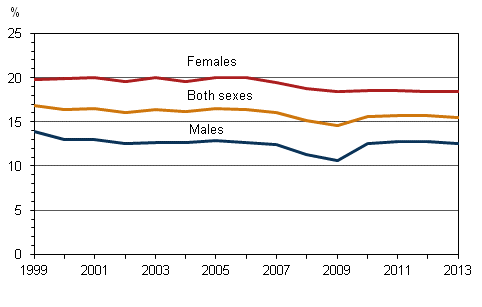
Two out of three temporary employees would want a permanent job
To an employee, temporary employment can be either a desired or involuntary form of employment. Approximately 25 per cent of temporary employees did not want a permanent job in 2013. The majority of them were aged between 15 and 24. Summer workers are a typical group of persons working voluntarily in temporary jobs.
However, a more common reason for working in a temporary employment relationship is that permanent work cannot be found. In 2013, the lack of permanent work was the reason why around 66 per cent of temporary employees worked in temporary jobs. The share of persons working involuntarily in temporary jobs among all temporary employees remained unchanged compared to 2012.
In 2013, there were 216,000 temporary employees on the labour market who had not found a permanent job even though they would have wanted one. Of them, 137,000 were women and 79,000 men. One year earlier, the number of persons working involuntarily in temporary jobs was slightly higher. Involuntary working under temporary contracts increases with age.
Around one-half of new employment contracts temporary
The number of employees with employment contracts of under one year's duration decreased from 2012. In 2013, such employees numbered 417,000, or around 18,000 fewer than in 2012. (Figure 12.)
Figure 12. Employees with employment contracts of under one year's duration in 2001-2013, persons aged 15 to 74
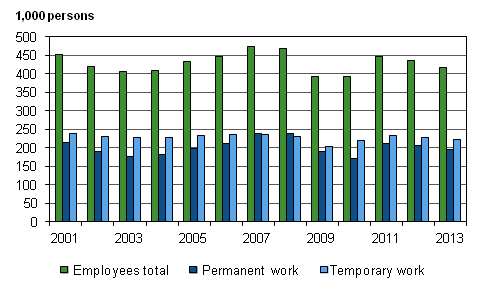
Fifty-three per cent of the employment contracts of under one year's duration were temporary. There has been a clear difference between women and men in whether a new employment relationship is temporary or permanent. In 2013, 59 per cent of women’s and 47 per cent of men’s new employment relationships were temporary, which was nearly the same as in 2012.
One per cent of employees did temporary agency work
Temporary agency work refers to an employment relationship in which an employee works via an enterprise which intermediates or hires labour force. In 2013, the average number of persons doing temporary agency work was 27,000, or about the same as in 2012. The shares of men and women doing temporary agency work were almost equal.
Among all employees, the share of temporary agency workers was only one per cent or so in 2013. Thus, doing temporary agency work is quite a marginal form of working on the Finnish labour market. Temporary agency work is most commonly done by young people: around five per cent of 15 to 24-year-old employees were doing it.
Temporary agency workers are employed by several industries. Their use is most usual in wholesale and retail trade, in hotel and restaurant activities and in manufacturing. Each of these industries employed a couple of thousand temporary agency workers.
2.5 Growth in number of part-time emplyees halted
Number of part-time employees highest in female-dominate industries
According to the Labour Force Survey, 370,000 employed persons worked part-time in 2013. Some 15 per cent of all employed persons worked part-time. Of them, 304,000 were employees. The Labour Force Survey data on part-time employment is based on the respondents’ own reporting. The following only concerns part-time employees.
In 2013, the number of part-time employees decreased by approximately 7,000 persons from 2012. The long-term trend in part-time employment has been a growing one since 1997. Part-time employment is more widespread among women than men. Persons employed part-time numbered 213,000, or 19 per cent, among female employees and 91,000, or nine per cent, among male employees. The number decreased slightly both for female and male employees compared to 2012. (Figures 13 and 14.)
Nearly three-quarters of the part-time employees worked in the private sector. The numbers of part-time employees were the highest in the female dominated industries of wholesale and retail trade, and human health and social work activities. The share of part-time employees of all employees was the largest, or 39 per cent, in retail trade (excl. motor vehicle trade).
Figure 13. Part-time employees aged 15 to 74 by sex in 2001-2013
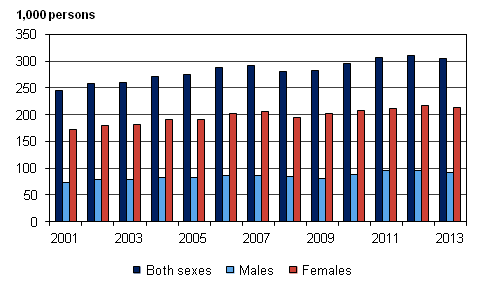
Figure 14. Share of part-time employees among employees aged 15 to 74 by sex in 2001-2013, %
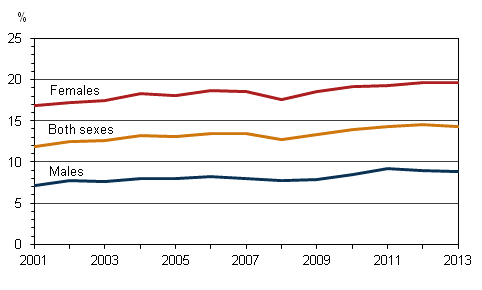
Studying is still the commonest reason for working part-time
Working part-time suits the life situation of many of those who are employed part-time. By contrast, part-time employment can be viewed as one form of underemployment in cases where the employee has not succeeded in finding full-time work even if he/she would have wanted it.
In 2013, studying was again the commonest reason why employees worked part-time. Approximately 30 per cent of part-time employees quoted this reason. Working part-time is widespread among employees between the ages of 15 and 24 of whom 39 per cent worked part-time in 2013.
Other reported reasons related to life situation were caring for children or relatives, and health reasons. Nearly all of those who reported caring for children or relatives as the reason for working part-time were women. For just under one-third of part-time employees the reason for working part-time was that full-time work was not available. In 2013, employees working part-time involuntarily numbered 83,000, of whom 61,000 were women and 23,000 men.
Among the 55 to 64-year-old employees, the number of part-time workers was 61,000, which was 17 per cent of all employees in this age group.
Source: Labour Force Survey 2013. Statistics Finland
Inquiries: Heidi Melasniemi-Uutela 09 1734 2523, Joanna Viinikka 09 1734 3796, tyovoimatutkimus@stat.fi
Director in charge: Riitta Harala
Updated 1.4.2014
Official Statistics of Finland (OSF):
Labour force survey [e-publication].
ISSN=1798-7857. Employment and unemployment 2013,
2 Employment and unemployment in 2013
. Helsinki: Statistics Finland [referred: 19.4.2025].
Access method: http://stat.fi/til/tyti/2013/13/tyti_2013_13_2014-04-01_kat_002_en.html

